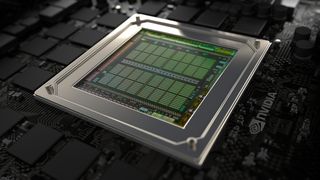Nvidia announces GTX 970M and 980M Maxwell mobile GPUs

Nvidia’s GM204 “Maxwell” architecture, the graphics technology inside the GTX 970 and GTX 980, is coming to laptops. If you follow graphics hardware closely, this might be confusing. Wait, you’d ask. Weren’t there already Maxwell 800M graphics chips, like the 860M in our favorite budget gaming laptop? Right you are! The thing is, that was an older generation of Maxwell (GM108), and Nvidia’s brushing that aside with the release of the second-gen architecture in its latest desktop--and now mobile--GPUs.
The GTX 980M and 970M are being pressed into gaming laptops at this very moment, and Nvidia claims that the mobile chips will be able to run games at ultra settings, even beyond 1080p resolution. More dramatically, Nvidia claims the GTX 980M will be 75% as powerful as the desktop GTX 980 (though you'll also see slides showing that number at 80%, which comes from "a composite of AAA game scores").
| Specs | GTX 970M | GTX 980M |
| Base clock | 924 MHz | 1038 MHz |
| CUDA cores | 1280 | 1536 |
| Memory config | Up to 3GB 192-bit GDDR5 | Up to 4GB 256-bit GDDR5 |
| Memory speed | 2500 MHz | 2500 MHz |
At Nvidia Editor’s Day back in September, Nvidia spent about 20 minutes talking about the 970M and 980M. Most of the presentation repeated subjects they’d already covered extensively, like the efficiency of MFAA and Maxwell’s support for voxel global illumination. I wrote about all of Maxwell’s new features, which you can read about here. Nvidia also mentioned that the M-series mobile GPUs will support Dynamic Super Resolution--that’s how they’ll be able to run games above 1080p, when most laptop displays max out at that resolution. You can read all about DSR here.
Then they got to the good stuff: power efficiency. The GTX 980M will offer roughly double the performance of the GTX 680M, but it should--that’s a GPU from 2012. The 980M won’t offer huge gains over the newer 880M, but Nvidia has done some major work on battery usage and on-battery performance, claiming 2x performance-per-watt versus last-gen Kepler. Without AC power, mobile GPUs are usually severely throttled to conserve battery life. Nvidia showed a demonstration of the GTX 680M running on AC power, then battery, which caused the framerate to drop from ~60 to an unplayable 10 or 20 fps.
A similar demonstration with the GTX 980 was able to hold a stable framerate even on battery power. So what does that really mean? Nvidia says Battery Boost, which was recently introduced with the 800M series GPUs, will keep games playable on battery power. One element of Battery Boost is that Nvidia has worked with OEMs like Asus and MSI to change or remove the GPU power restrictions they’ve previously instituted to conserve power. That’s more about talking than technology.

Another element are the BatteryBoost settings built into the GeForce Experience. Nvidia now lets you set a maximum framerate to cap a game at. Their example is 30 fps, and likely capping a game at 60 fps on a mobile GPU wouldn’t do much to preserve battery life or increase performance. Battery-verus-performance settings will be adjustable in GFE, but we don’t know yet how granular those adjustments will be.
Lastly, Nvidia has incorporated programming into BatteryBoost to deliver each component in a laptop exactly the amount of juice it needs to render a game, and nothing more. What does that mean, exactly? For the GPU, it means dynamically throttling performance to use just as much power as is necessary to maintain a smooth framerate. It’s unclear exactly how much control Nvidia has over the amount of power used by the other components in the system.
The biggest gaming news, reviews and hardware deals
Keep up to date with the most important stories and the best deals, as picked by the PC Gamer team.
And, naturally, not every gaming laptop is going to behave identically with Nvidia’s new GTX 980M and 970M. Remember, the first part of the equation is how closely Nvidia has worked with an OEM to let Battery Boost control GPU performance; some OEMs may still have their 900M series laptops throttle performance on battery via BIOS settings.
We’ll have some hands-on testing with MSI’s GT72 Dominator Pro, with a GTX 980M on board, in the near future. Check back soon to see some analysis of the 980M in action, and whether it’s actually able to deliver 80% of the performance of its desktop big brother.

Wes has been covering games and hardware for more than 10 years, first at tech sites like The Wirecutter and Tested before joining the PC Gamer team in 2014. Wes plays a little bit of everything, but he'll always jump at the chance to cover emulation and Japanese games.
When he's not obsessively optimizing and re-optimizing a tangle of conveyor belts in Satisfactory (it's really becoming a problem), he's probably playing a 20-year-old Final Fantasy or some opaque ASCII roguelike. With a focus on writing and editing features, he seeks out personal stories and in-depth histories from the corners of PC gaming and its niche communities. 50% pizza by volume (deep dish, to be specific).
Most Popular

